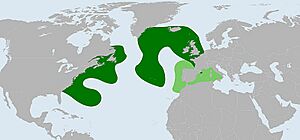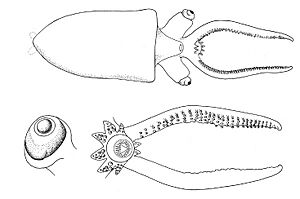Atlantic cranch squid facts for kids
Quick facts for kids Atlantic cranch squid |
|
|---|---|
 |
|
| Teuthowenia megalops swimming in the "cockatoo" posture | |
| Conservation status | |
| Scientific classification | |
| Genus: |
Teuthowenia
|
| Species: |
megalops
|
 |
|
| Distribution of Teuthowenia megalops:
Confirmed presence Possible range |
|
| Synonyms | |
|
|
The Teuthowenia megalops, also known as the Atlantic cranch squid, is a type of glass squid. You can find it in the cool and mild waters of the northern Atlantic Ocean. These squids are medium-sized, with their bodies (called the mantle) growing up to about 40 centimeters (16 inches) long.
They have very big eyes, which is why their scientific name megalops means "large eyes" in Greek. A cool fact about them is that, like other squids in their group (the Teuthowenia genus), they have three special light-producing organs (bioluminescent photophores) on each eyeball. These organs glow in the dark ocean!
Contents
What Does the Atlantic Cranch Squid Look Like?
Atlantic cranch squids are medium-sized glass squids. They show differences between males and females in size. Females can grow to be between 37 and 40 cm (15 to 16 inches) long. Males are smaller, usually 18.2 to 24.4 cm (7.2 to 9.6 inches) long.
Their eyes are very large and face forward. Each eye has three special light-producing organs called photophores. This is a key feature that helps identify them as Teuthowenia squids. One photophore is small and oval-shaped, located near the top of the eye's lens. The other two are larger and shaped like crescents, found on the sides and bottom of the eyeball.
The squid's body, or mantle, is shaped like a cone and is long and thin at the back. Its skin is thin and feels like leather. They have long, narrow fins that start about halfway down their body. These fins extend past the end of the body and join together, ending in two small flaps.
Their arms are short to medium in length, about a quarter to half the length of their body. In young squids and females, the third pair of arms is the longest. All their arms have two rows of cup-shaped suckers that do not have hooks. The suckers in the middle of the second and third pairs of arms are much larger than the others.
In adult males, the arms are specially changed for mating. For example, the first pair of arms becomes longer and thicker. The suckers on the tips of the second pair of arms have small, pointed teeth.
The tentacles are short and strong. They have four rows of suckers arranged in a zigzag pattern on the outer part of the tentacles. The suckers on the tentacle clubs have many small, sharp teeth all around their edges.
Where Do Atlantic Cranch Squids Live?
Atlantic cranch squids are pelagic (meaning they live in the open ocean) and deep-water creatures. They are found swimming in the ocean at depths from about 405 to 4,515 meters (1,300 to 14,800 feet). The water temperature in these deep areas ranges from 3 to 21 °C (37 to 70 °F). Sometimes, adult squids can be found closer to the surface, less than 25 meters (82 feet) deep.
These squids perform a daily vertical migration. This means they move closer to the surface at night and dive deeper during the day. Young squids (called paralarvae and subadults) usually stay in the upper 300 meters (980 feet) of the ocean. As they grow bigger, they gradually move to deeper waters.
The Atlantic cranch squid lives only in the cool and mild waters of the northern Atlantic Ocean. In the western Atlantic, they are found along the eastern coast of North America, from Canada to Georgia in the United States. Their range extends eastward towards Bermuda. In the northeastern Atlantic, they live between Greenland and Iceland, and south towards the Azores. They are also found around Great Britain and Ireland. They are quite common and are often seen by underwater vehicles. Younger squids are also often caught in shallower waters.
Other types of Teuthowenia squids live in different parts of the world, so their location can help scientists identify them. For example, Teuthowenia pellucida lives in the southern hemisphere, and Teuthowenia maculata lives off the coast of West Africa.
How Do Atlantic Cranch Squids Live?
Like other squids in the family Cranchiidae, Atlantic cranch squids have an amazing way to float in the water. They have large, two-part internal chambers filled with a special liquid called ammonium chloride. This liquid is lighter than water, which helps the squid float without much effort. If these chambers are punctured, the squid sinks quickly. These chambers also have muscles that gently contract and expand. This movement helps water flow in and out of the mantle cavity, allowing the squid to breathe.
Because of this special floating system, Atlantic cranch squids are slow swimmers. They don't need to use their mantle muscles to breathe like other squids. However, this also means they can't quickly jet away from danger. They usually float calmly in a position called the "cockatoo" posture. This is common for glass squids, which are sometimes called cockatoo squids because of it. In this posture, they look like a horizontal cockatoo. They can rotate their bodies, but their internal digestive glands always stay upright, no matter which way the squid is facing.
Life Cycle of the Atlantic Cranch Squid
Scientists haven't seen much of the Atlantic cranch squid's full life cycle. It's thought that they mate and lay eggs in the deep ocean, more than 1,000 meters (3,300 feet) down. It's very dark at these depths, so their glowing light organs and special chemicals (pheromones) might help them find partners. Females lay eggs only once before they die. No eggs have been found in the wild, but studies suggest a female can lay between 70,000 and 80,000 eggs.
After hatching, the tiny baby squids, called paralarvae, slowly float or swim towards shallower waters. These babies look different from adults. They have rounder bodies and very small fins. Their eyes are small but already have developing light organs. As they grow, they gradually move to deeper waters.
The Atlantic cranch squid is estimated to live for about two to three years.
Who Eats the Atlantic Cranch Squid?
Atlantic cranch squids are a food source for many ocean predators. They are eaten by large predatory fish like the blue shark and swordfish. They are also a big part of the diet for cetaceans (ocean mammals like whales and dolphins). These include the long-finned pilot whale, bottlenose whale, sperm whale, and Cuvier's beaked whale.
How Does the Atlantic Cranch Squid Defend Itself?
The Atlantic cranch squid has a very unusual way of defending itself when it feels threatened. At first, it acts like other squids: it releases a cloud of ink into the water and quickly jets away.
But if the danger doesn't go away, it does something amazing: it inflates itself into a perfect ball! This happens in a few steps. First, it turns its fins and internal shell inside out. Then, its head and arms pull back into its body. Next, it fills its mantle with seawater, making itself completely round. The tentacles are the last to be pulled in. At this point, its chromatophores (tiny color-changing cells that are usually just pinpoints on its clear body) expand to four times their normal size. They form circles on its bloated body, which can confuse predators about where the squid's eyes are.
If the threat is still there, its last move is to release more ink. But this time, the ink stays inside its now spherical body. The squid turns into a completely black, opaque ball.
The squid stays in this ball shape for about half an hour. Then, it slowly starts to extend its head and tentacles, followed by its fins and internal shell. Once it's sure the danger is gone, it gradually releases the ink and seawater from its body. All of this happens without the squid getting hurt, even though its body went through some extreme changes!
This incredible behavior was first seen in live squids in 1972 by a marine biologist named Peter Noel Dilly. It was the first time such a defense was observed in any cephalopod. Since then, similar behaviors have been found in other glass squids, like Cranchia scabra and Teuthowenia pellucida.
About the Name: Atlantic Cranch Squid
The Teuthowenia megalops is one of three species in the group called Teuthowenia. These squids belong to the larger family known as Cranchiidae. They don't have many common names that people widely use. However, the Food and Agriculture Organization (FAO) of the United Nations calls them the Atlantic cranch squid in English.
The scientific names of these squids have changed many times over the years. This can be confusing! For example, this squid has been called by different names like Cranchia megalops and Taonius megalops in the past.
How the Name Changed Over Time
The Atlantic cranch squid was first described by a Danish zoologist named Ferdinand Victor Alphons Prosch in 1849. He called it Cranchia megalops. The name megalops comes from Greek words meaning "great eyes," because of its large eyes.
Over the years, many scientists studied these squids and sometimes gave them new names or put them in different groups. This happened because they might have found young squids that looked different from adults, or they didn't have all the information about the species. For example, in 1856, another Danish zoologist, Japetus Steenstrup, found a squid he named Leachia hyperborea. Later, it was discovered that this was actually the same species as Cranchia megalops, just at a different life stage!
It wasn't until 1956 that a Danish marine biologist, Bent J. Muus, realized that Prosch's Cranchia megalops and Steenstrup's Leachia hyperborea were the same species. He combined them under one name. Finally, in 1985, an American malacologist (a scientist who studies molluscs) named Nancy A. Voss helped clear up the confusing history of the Cranchiidae family. She confirmed that the correct scientific name for this species is Teuthowenia megalops.
See Also
- Teuthowenia pellucida, the googly-eyed glass squid
- Megalocranchia fisheri







